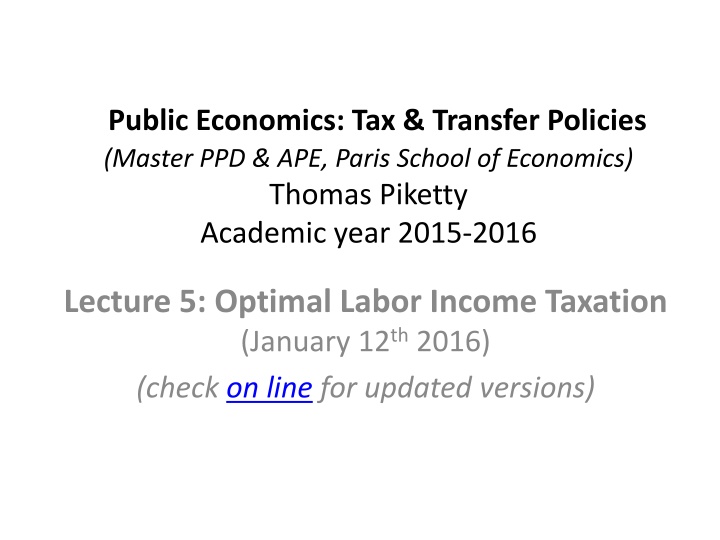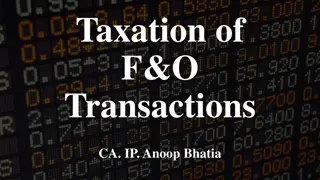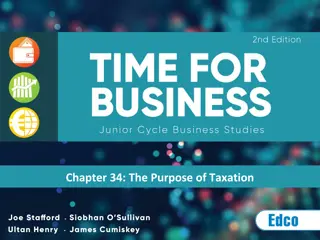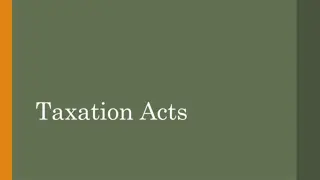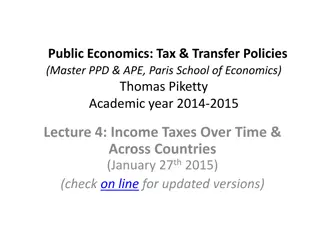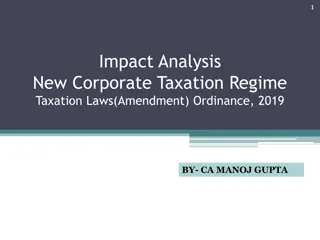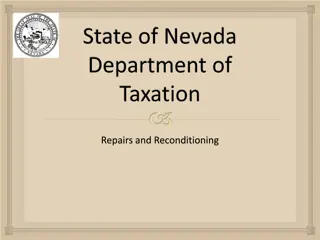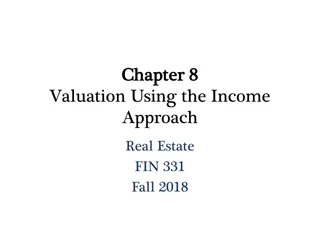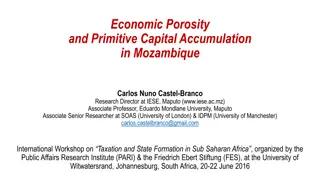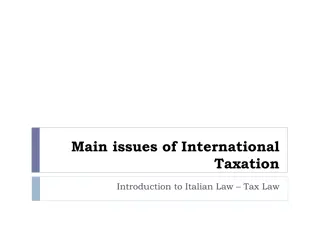Optimal Labor Income Taxation: Main Theoretical Results and Intuitions
The optimal taxation of labor income involves a U-shaped pattern of marginal tax rates, with top rates influenced by income concentration and labor supply elasticities. Mirrlees' model analyzes optimal labor income taxes based on productivity and labor supply decisions, aiming to maximize social welfare subject to budgetary constraints.
Download Presentation

Please find below an Image/Link to download the presentation.
The content on the website is provided AS IS for your information and personal use only. It may not be sold, licensed, or shared on other websites without obtaining consent from the author.If you encounter any issues during the download, it is possible that the publisher has removed the file from their server.
You are allowed to download the files provided on this website for personal or commercial use, subject to the condition that they are used lawfully. All files are the property of their respective owners.
The content on the website is provided AS IS for your information and personal use only. It may not be sold, licensed, or shared on other websites without obtaining consent from the author.
E N D
Presentation Transcript
Public Economics: Tax & Transfer Policies (Master PPD & APE, Paris School of Economics) Thomas Piketty Academic year 2015-2016 Lecture 5: Optimal Labor Income Taxation (January 12th2016) (check on line for updated versions)
Main theoretical results about optimal taxation of labor income (for capital income, see lectures 6-7): (1) the social optimum usually involves a U-shaped pattern of marginal tax rates = in order to have high minimum income, one needs to withdraw it relatively fast (but not too fast) = relatively consistent with observed patterns (if we take into account transfers) (2) optimal top rates depends positively on income concentration (top income shares) and negatively on labor supply elasticities (and positively on bargaining power at the top: very important if we want to understand Roosevelt-type confiscatory tax rates)
Here I will only present the main results and intuitions. For complete technical details and proofs, see the following papers: Mirrlees, J., "An exploration in the theory of optimum income taxation", RES 1971 Diamond, P., Optimal Income Taxation: An Example with a U-Shaped Pattern of Optimal Marginal Rates , AER 1998 [article in pdf format] Saez, Using Elasticities to Derive Optimal Income Tax Rates , RES 2001 [article in pdf format] Piketty-Saez, "Optimal Labor Income Taxation", 2013, Handbook of Public Economics, vol. 5 Piketty-Saez-Stantcheva, "Optimal Taxation of Top Labor Incomes: A Tale of Three Elasticities", AEJ 2013 (see also Slides)
The optimal labor income tax problem Mirrlees (1971) : basic labor supply model used to analyze optimal labor income taxes Each agent i is characterized by an exogeneous wage rate wi(=productivity) Labor supply li Pre-tax labor income yi= wili Income tax t = t(yi) t(yi) can be >0 or <0 : if <0, then this is an income transfer, or negative income tax After-tax labor income zi= yi t(yi) Agents choose labor supply liby maximizing U(zi,li)
Social welfare function W = W(U(zi,li)) f(yi)dyisubject to budgetary constraint: t(yi) f(yi)dyi= 0 (or = G, with G = exogenous public spendings) ( f(yi) = density function for yi= partly endogenous, given exogenous distribution of productivities wiand endogenous labor supply li) If individual productivities wiwere fully observable, then the first-best efficient tax system would be t=t(wi), i.e. would not depend at all on labor supply behaviour, so that there would be no distorsion = lump-sum transfers, fully efficient redistribution However if the tax system can only depend on income, i.e. t = t(yi), e.g. because of unobservable productivites wi (adverse selection), then we have an equity/efficiency trade-off >>> Mirrlees 1971 provides analytical solutions for the second-best efficient tax system in presence of such an adverse selection pb
But problems with the Mirrlees 1971 formula: (i) very complicated and unintuitive formulas, hard to apply empirically (ii) only robust conclusion: with finite number of productivity types wi, , wn, then zero marginal rate on the top group = completely off-the-mark >>> Diamond (1998), Saez (2001): continuous distribution of types (no upper bound, so that the artificial zero-top-rate result disappears), first- order derivation of the optimal tax formulas, very intuitive and easy-to-calibrate formulas
First-order derivation of linear optimal labor income tax formulas Linear tax schemes: t(y) = ty t0 I.e. t = constant marginal tax rate t0>0 = transfer to individuals with zero labor income (RMI/RSA in France) Define e = labor supply elasticity Definition: if the net-of-tax wage rate (1-t)wi increases by 1%, labor supply li(and therefore labor income yi=wili, for given wi) increases by e% E.g. if U(zi,li) = zi- V(li) (separable utility, no income effect), with V(l)=l1+ /(1+ ), then e=1/ FO condition: Max wili- V(li) li= wi1/ dli/li= e dwi/wiwith e=1/
More generally, whatever the labor income generating process yi= y(wage rate wi, labor hours li, effort ei, luck ui), one can always define e = generalized labor supply elasticity = elasticity of labor income with respect to the net-of-tax rate: if the net-of-tax rate (1-t) increases by 1%, observed labor income y increases by e% I.e. if t t+dt, then 1-t 1-t-dt, so that 1-t declines by dt/(1-t)%; therefore we have: dy/y = - e dt/(1-t) The generalized elasticity reflects changes in labor hours but also endogenous changes in wage rates: with higher taxes, maybe one will put less effort in education investment, or less effort in trying to get a promotion, etc.
Assume that were looking for the tax rate t* maximizing tax revenues R = ty Revenue-maximizing tax rate t* = top of the Laffer curve Revenue-maximizing tax rate t* = social optimum if social welfare function W = Rawlsian (infinitely concave), i.e. in the limit case where the marginal social welfare W =0 for all U>Umin, i.e. social objective = maximizing minimum utility (maxmin) = maximizing transfer t0 = useful reference point: by definition, socially optimal tax rates for non-Rawlsian social welfare functions W will be below revenue-maximizing tax levels
First-order condition: if the tax rate goes from t to t+dt, then tax revenues go from R to R+dR, with: dR = y dt + t dy with dy/y = - e dt/(1-t) I.e. dR = y dt t ey dt/(1-t) dR = 0 if and only if t/(1-t) = 1/e I.e. t* = 1/(1+e) I.e. pure elasticity effect : if the elasticity e is higher, then the optimal tax t* is lower I.e. if e=1 then t*=50%, if e=0,1 then t*=91%, etc. = the basic principle of optimal taxation theory: other things equal, don t tax what s elastic Other example: Ramsey formulas on optimal indirect taxation: tax more the commodities with a less elastic demand, and conversely
First-order derivation of non-linear optimal labor income tax formulas General non-linear tax schedule t(y) I.e. marginal tax rates t (y) can vary with y Note f(y) the density function for labor income, and F(y)= z<yf(z)dz = distribution function ( = fraction of pop with income < y ) Assume one wants to increase the marginal tax rate from t to t +dt over some income bracket [y; y+dy]. Then tax revenues go from R to R+dR, with: dR = (1-F(y)) dt dy f(y)dy t ey dt /(1-t ) dR = 0 if and only if t */(1-t *) = (1-F(y))/yf(y) 1/e
Key formula: t*/(1-t*) = (1-F(y))/yf(y) 1/e I.e. two effects: Elasticity effect: higher elasticities e imply lower marginal tax rates t * Distribution effect: higher (1-F)/yf ratios imply higher marginal rates t * Intuition : (1-F)/yf = ratio between the mass of people above y (=mass of people paying more tax) and the mass of people right at y (=mass of people hit by adverse incentives effects) For low y, the ratio (1-F)/yf is necessarily declining: other things equal, marginal rates should fall But for high y, the ratio (1-F)/yf is usually increasing: other things equal, marginal rates should rise >>> for constant elasticity profiles, U-shaped pattern of marginal tax rates
Asymptotic optimal marginal rates for top incomes With a Pareto distribution 1-F(y) = (k/y)aand f(y)=aka/y(1+a), then (1-F)/yf converges towards 1/a, i.e. t * converges towards: t * = 1/(1+ae) with e= elasticity, a = Pareto coefficient Intuition: higher a (i.e. lower coefficient b=a/(a-1), i.e. less fat upper tail = less income concentration) imply lower tax rates, and conversely Exemple: if e=0,5 and a=2, t * = 50% But if e=0,1 and a=2, t * = 83%
Reminder on key property of Pareto distributions: ratio average/threshold = constant Note y*(y) the average income of the population above threshold y. Then y*(y) can be expressed as follows : y*(y) = [ z>yz f(z)dz ] / [ z>yf(z)dz ] = [ z>ydz/za] / [ z>ydz/z(1+a)] = ay/(a-1) I.e. y*(y)/y = b = a/(a-1) (and a = b/(b-1) ) In practice : b is usually around 2, but can vary quite a lot For top incomes France 2010s, US 1970s: b = 1.7-1.8 (a=2.2-2.3) France or US 1910s, US 2010s: b = 2.2-2.5 (a=1.7-1.8) For top wealth: France today: b = 2.3-2.5; France 1910s: b=3-3.5 Higher b coefficients = fatter upper-tail of the distribution = higher concentration of income (or wealth)
Evidence on U-shaped pattern of marginal rates The distribution effect (1-F(y))/yf(y) is typically U- shaped; so if elasticity effect e=e(y) stable over y, then the social optimum involves a U-shaped pattern of marginal tax rates Same conclusion with general SWF as long as marginal social welfare weights not too far from Rawlsian social welfare function Basic intuition = in order to have high minimum income, one needs to withdraw it relatively fast (but not too fast) = relatively consistent with observed patterns (if we take into account transfers) t */(1-t *) = (1-F(y))/yf(y) 1/e
The increasing part of the U-shaped pattern (for upper half incomes) is due to income tax progressivity rising marginal rates at the top The decreasing part (for bottom half incomes) is due to the withdrawal of income transfers, which also creates high marginal rates Observed pattern of marginal rates in France: U-shaped curve (see RFE 97 graphs, paper)
Simplified example for France 2013 (see here for detailed simulations and computer codes for French transfers & taxes) If labor income y=0, then t(y)=-t0: t0= transfer to individuals with zero labor income 500 /month for RMI/RSA in France If labor income y=ymin=full-time minimum wage, you receive no transfer any more (unless you have children); net minimum wage 1100 /m, gross min. wage 1400 /m, total labor cost 1700 /m (CSG+employee payroll tax 20%; employer payroll tax 20%) Note: total labor cost would be 2000 /m at the level of the minimum wage in the absence of low-wage payroll tax cut: employer payroll tax 20% at ymin back to 40% at 1,6 x ymin
As pre-tax income y goes from y=0 to y=1700, after-tax income y-t(y) goes from 500 to 1100 , and t(y) goes from -500 to +600 , i.e. rises by 1100 marginal tax rate associated to the transition between pre- tax incomes 0 and ymin= t/ y = 1100/1700 = 65% (if we include VAT & other indirect taxes, the marginal tax rate on minimum wage workers would be closer to 75-80%) The pb is that if one wants to reduce this marginal rate (say, by further cuts in low-wage payroll tax), then one has to raise the marginal rate higher up in the distribution (say, btw ymin and 1,6 x ymin) complex trade-off, current U-shaped pattern might be not too far from optimal
Evidence on top marginal rates Observed top marginal rates go from 20-30% to 80-90% One possible interpretation = different beliefs about elasticities of labor supply (see this paper for a learning model: it is difficult to estimate e with certainty) t * = 1/(1+ae) (with e= elasticity, a = Pareto coefficient) If e=1 and a=2, t * = 33% If e=0,5 and a=2, t * = 50% If e=0,1 and a=2, t * = 83%
Empirical evidence: real labor supply elasticities 0,2-0,3 at most (higher elasticities usually come from pure income shifting, i.e. if one can transfer income to a less taxed tax base: in principle, this can be solved by a broader tax base) t * 60-70% ? See P. Diamond & E. Saez, "The Case for a Progressive Tax: From Basic Research to Policy Recommendations", JEP 2011 For a survey on empirical estimates of labor supply elasticities, see E. Saez, J. Slemrod and S. Gierz, The Elasticity of Taxable Income with Respect to Marginal Tax Rates: A Critical Review , NBER 2009 [article in pdf format]
However the perfect-competition model (labor income = marginal product) may not be sufficient to analyze Roosevelt-type tax rates & the recent surge in US top incomes A model with imperfect competition and CEO bargaining power (CEOs can sometime extract some than their marginal product) is more promising See Piketty-Saez-Stantcheva, "Optimal Taxation of Top Labor Incomes: A Tale of Three Elasticities", AEJ 2014 (see also Slides)
With imperfect competition and bargaining power, the optimal tax formula becomes more complicated and can justify confiscatory tax rates Augmented formula: = (1+tae2+ae3)/(1+ae) With e = e1+ e2+ e3 = labor supply elasticity e1+ income shifting elasticity e2 + bargaining elasticity e3(= more intensive bargaining with lower tax rate) Key point: as elasticity e3 for a given total elasticity e, the decomposition between the three elasticities e1,e2,e3is critical
